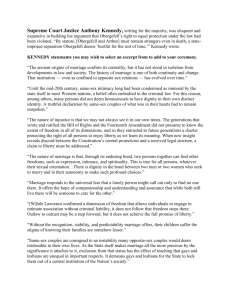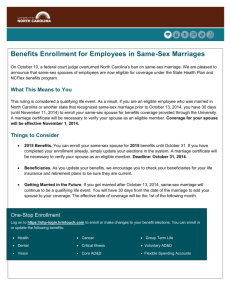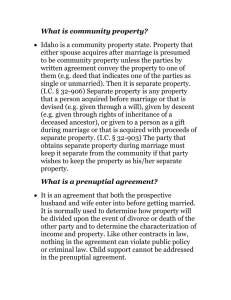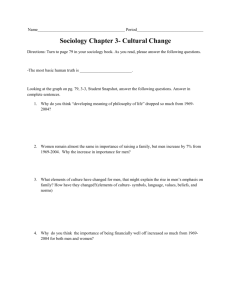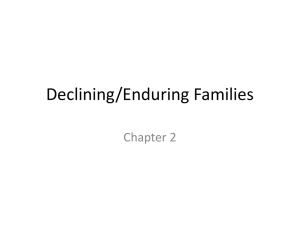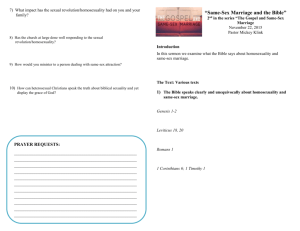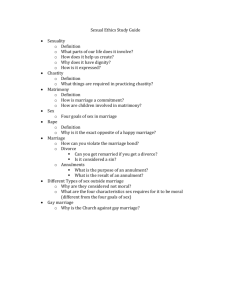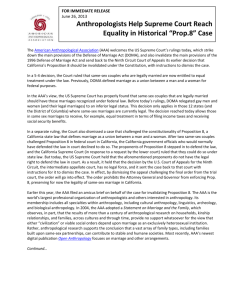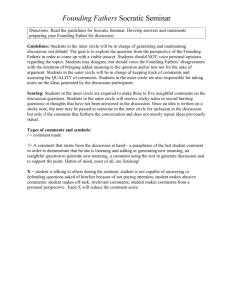Daniels WPSA 2014 Paper - Western Political Science
advertisement
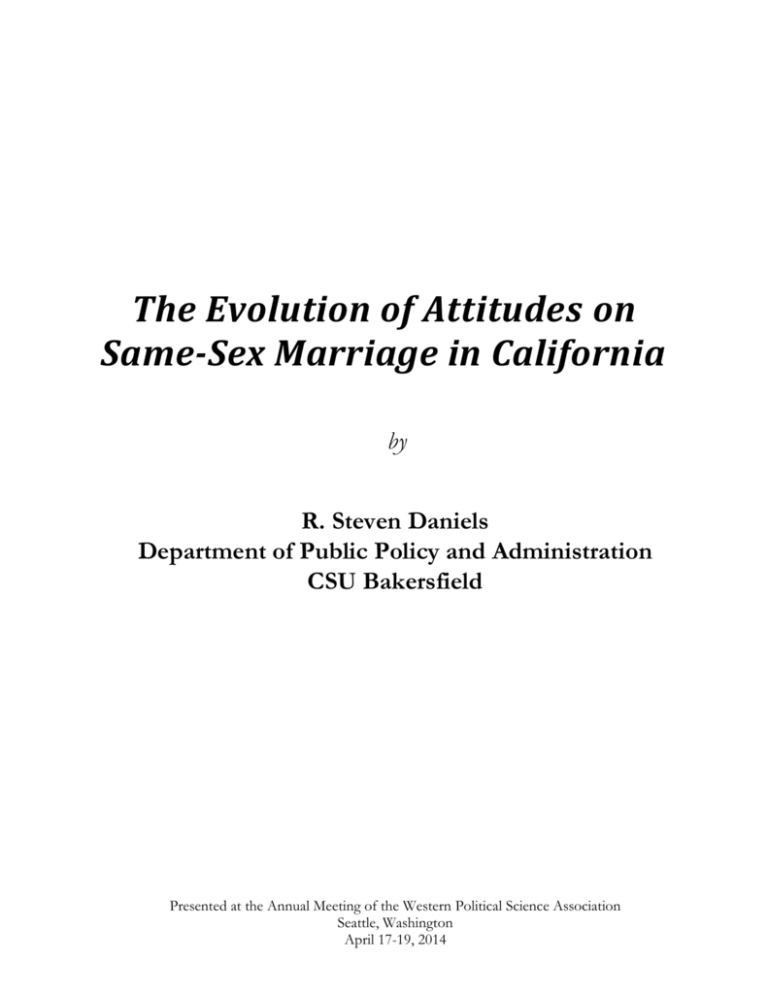
The Evolution of Attitudes on Same-Sex Marriage in California by R. Steven Daniels Department of Public Policy and Administration CSU Bakersfield Presented at the Annual Meeting of the Western Political Science Association Seattle, Washington April 17-19, 2014 Abstract This article focuses on two inter-related research questions: 1) Is the gradual shift in public opinion noted by the Pew Research Center at the national level also present among California voters? 2) Are the factors affecting attitudes toward same-sex marriage the same in California and the United States. The data from this analysis come from surveys conducted by Public Policy Institute of California between 2005 and 2013. Support for same-sex marriage increased in both the United States and in California, although support for same-sex marriage was stronger in California than in the U.S. by about 5 percent. The strongest direct explanatory factors were similar to those at the U.S. level: partisanship, ideology, and religious intensity. However, a range of demographic, political, social, regional, and time factors had a significant effect on support. Overall, the increased support for same-sex marriage appears to be a permanent shift in the political landscape. The change reflects a shift in the dominant issue frame from the policy debate over same-sex marriage. i Table of Contents Abstract ......................................................................................................................................................... i Table of Contents ....................................................................................................................................... ii List of Figures ............................................................................................................................................. iii List of Tables .............................................................................................................................................. iii Introduction ................................................................................................................................................. 1 Issue Framing in the Same-Sex Marriage Debate in California ............................................................ 2 Factors Influencing Opinion on Same-Sex Marriage ............................................................................ 5 Research Design and Methodology .......................................................................................................... 8 Data Set .................................................................................................................................................... 8 Measurement ........................................................................................................................................... 8 Dependent Variables ......................................................................................................................... 8 Independent Variables....................................................................................................................... 9 Analysis .................................................................................................................................................... 9 Limitations .............................................................................................................................................10 Results .........................................................................................................................................................10 Is the Increase in Support for Same-Sex Marriage Apparent in California? ................................10 What are the Dominant Influences on Support for Same-Sex Marriage in California?.............11 Conclusion .................................................................................................................................................13 References ..................................................................................................................................................14 ii List of Figures Figure 1. Increasing U.S. and California Support for Same-Sex Marriage, 2005-2013 ...................10 List of Tables Table 1. The Influence of Sociodemographic, Religious, and Political Factors on Attitudes toward Same-Sex Marriage in California, 2005-2012..................................................................................12 iii 1 Introduction On May 15, 2008, the California Supreme Court ruled that existing statutory and initiative measures that limited civil marriage to heterosexual couples violated the California Constitution’s guarantee of equal protection (In Re Marriage Cases, 2008). On November 4, 2008, California voters passed Proposition 8, a constitutional initiative invalidating In re Marriage Cases and stopping same-sex marriages in the state. The Proposition itself was ruled unconstitutional by a U.S. Federal District Court in 2010 (Perry v. Schwarzenegger, 2010). The U.S. Court of Appeals, Ninth Circuit, affirmed in 2012 that Proposition 8 was a violation of the Equal Protection Clause of the U.S. Constitution (Perry v. Brown, 2012). The U.S. Supreme Court accepted the appeal of Proposition 8 proponents and held oral arguments on March 26, 2013. On June 26, 2013, the Supreme Court ruled that the petitioners, the authors of Proposition 8, did not have standing to sue if the state refused to defend the legislation (Hollingsworth v. Perry, 2013). The decision allowed the original decision in Perry v. Schwarzenegger to declare Proposition 8 unconstitutional to stand. Research done in the aftermath of the election confirmed that voter partisanship, ideology, religiosity, and ethnicity played central roles in the final 52% to 48% vote (Abrajano, 2010) (Egan & Sherrill, 2009). However, surveys since the passage of Proposition 8 have suggested a sea change in public opinion on the issue of same-sex marriage across nearly all groups with a plurality now supporting same-sex marriage across the country (Pew Research Center, 2013, February 7); see also (Baunach, 2012). In California, support for same-sex marriage has risen to a 61% majority (Field Research Corporation, 2013). This article focuses on two inter-related research questions: 1) Is the gradual shift in public opinion noted by the Pew Research Center at the national level also present among California voters? 2) Are the factors affecting attitudes toward same-sex marriage the same in California and the United States. The data from this analysis come from surveys conducted by Public Policy Institute of California between 2005 and 2013. 2 The current research suggests that support for same-sex marriage increased in both the United States and in California, although support for same-sex marriage was stronger in California than in the U.S. by about 5 percent. The strongest direct explanatory factors were similar to those at the U.S. level: partisanship, ideology, and religious intensity. However, a range of demographic, political, social, regional, and time factors had a significant effect on support. Overall, the increased support for same-sex marriage appears to be a permanent shift in the political landscape. The change reflects a shift in the dominant issue frame from the policy debate over same-sex marriage. Issue Framing in the Same-Sex Marriage Debate in California Issue framing has played a critical role in the debate on same-sex marriage. The literature on issue framing suggests that elite framing of policy issues is a major tool for shaping the political debate on policy issues in the U.S. “Invented by elites and carried by mass media, frames influence public opinion by circumscribing the considerations citizens take seriously” (Nelson & Kinder, 1996, p. 1074). Much of the debate on same-sex marriage, and gay rights generally, has turned on a fundamental conflict in values between traditional morality and equality. Drawing from the Supreme Court decision in Romer v. Evans that struck down a Colorado constitutional initiative banning government action to protect sexual orientation (Romer v. Evans, 1996), Brewer (Brewer, 2008) has identified three issue frames that have consistently dominated the discussion of gay rights generally and same-sex marriage specifically: traditional morality, equal rights, or special rights. The equality frame appears in the majority opinion by Justice Anthony Kennedy: One century ago, the first Justice Harlan admonished this Court that the Constitution “neither knows nor tolerates classes among citizens.” Plessy v. Ferguson, 163 U. S. 537, 559 (1896) (dissenting opinion). Unheeded then, those words now are understood to state a commitment to the law’s neutrality where the rights of persons are at stake. The Equal Protection Clause enforces this principle and today requires us to hold invalid a provision of Colorado’s Constitution (Romer v. Evans, 1996, p. 623). 3 Both the traditional morality frame and the special rights frame appear in the dissenting opinion by Justice Antonin Scalia: The constitutional amendment before us here is not the manifestation of a “‘bare . . . desire to harm’ ” homosexuals, ante, at 634, but is rather a modest attempt by seemingly tolerant Coloradans to preserve traditional sexual mores against the efforts of a politically powerful minority to revise those mores through use of the laws [Traditional morality] (p. 636). . . The amendment prohibits special treatment of homosexuals, and nothing more [Special rights] (p. 638). As a result, the debate on same-sex marriage falls squarely in the area of morality politics. Unlike other policy arenas characterized by high information costs and limited access, morality politics features conflict over fundamental values. Gusfield has argued that debates over morality are really about the redistribution of values (Gusfield, 1963); see also (Meier, 1999). The competing sides attempt to replace one set of values in society with another. Because morality policies concern fundamental values, they are also marked by simplicity, low information requirements, and high salience to the public. The ease of access and importance to individual citizens generates high levels of citizen participation (Mooney, 1999). Since morality politics focuses on fundamental notions of right and wrong, everyone can act as an expert on the issue and genuine expertise (if such a thing exists in morality policy) has little impact on the outcome. The key to morality policy is issue framing. All “bad” human behaviors (“sins”) are multidimensional in practice (Meier, 1999). However, if one side of the debate can successfully characterize the behavior under examination as sin, the development of a counter-balancing political opposition becomes much less likely. As Meier notes, “Legislators do not rise and recite the joys of drunk driving, the pleasures of prostitution, or the thrill they get from serial killings” (Meier, 1999, p. 683). On the other hand, if opponents of regulating the behavior can frame the issue in a constructive way, the debate begins to resemble the classic political model of redistributive politics, an arena where the most important explanatory factors are “the distribution of citizen values, the competitiveness of parties, and the party affiliations of politicians” (Haider-Markel & Meier, 1996). 4 The available evidence clearly suggests that gay rights as an issue has made the transition from the politics of sin to the politics of redistribution. Like many other issues initially defined as traditional morality issues such as miscegenation (Novkov, 2008), abortion (Norrander & Wilcox, 1999), and gambling (Pierce & Miller, 1999); gay rights as an issue has shifted from an overall condemnation of homosexuality to an increasing acceptance of gay rights on equality grounds. Brewer reported major support for protections against job discrimination and service in the military as early as 1977 (Brewer, 2008, p. 22). Even more controversial issues have reached majority or plurality approval. A Gallup/USA Today poll reported support for gay adoption reached major status nationally in 2008 (Princeton Survey Research Associates International/Newsweek, 2008). The Pew Research Center for the People and the Press identified plurality support for same-sex marriage in late 2011 (Pew Research Center for the People and the Press, 2011). In California, available evidence suggests that the shifts occurred earlier and more broadly, despite the final vote in Proposition 8. Support for Proposition 21 in 2000, a statutory initiative that limited marriage to a man and a woman was 61.4%, passing in 52 of 58 counties (California Secretary of State, 2000). Support for Proposition 8 in 2008 was 52.3%, passing in 41 of 58 counties (California Secretary of State, 2008). This represented a nine percentage point and 11 county shift in eight years. The poll results reported earlier from the Field Poll suggest an additional nine percentage point increase in support for same-sex marriage in less than five years. The polling data clearly suggest that elites, the media, and the public had clearly identified the competing frames of traditional morality and equality as early as the 1970s on workplace discrimination against gays and lesbians and that these frames have become increasingly representative of the nationwide and California debate over gay rights. The public debate on the passage of Proposition 8 certainly used all of these frames to promote or oppose the proposition. The official campaign sign of ProtectMarriage.com, the official sponsor of Proposition 8 stated simply, “Yes on 8: Restore Marriage”. The official sign of No on Proposition 8 just as bluntly argued, “Vote No on Prop 8: Unfair & Wrong”. 5 The rise of competitive issue frames suggests that political conflict and public attitudes toward same-sex marriage should reflect, at least in part, the factors noted by Haider and Markel: ideology, party competitiveness, and partisanship (Haider-Markel & Meier, 1996). I examine these and other influences in the next section. Factors Influencing Opinion on Same-Sex Marriage Stacey Horn has argued that attitudes about sexual orientation are more multidimensional and complex than is frequently given credit in the literature on the subject (Horn, 2013). After examining the available literature, she concludes that these attitudes reflect a complex interaction among demographic and situational factors, personality traits, and target characteristics affecting specific attitude issues within a particular social, cultural, or situation context. The mix of relevant factors changes depending on the specific attitude under examination. The same individual may have negative attitudes toward homosexuality but may also believe that individuals should not be legally discriminated against because of those behaviors. The specific attitudes may reflect the influences of different factors. To prevent inconsistent interpretations, this article focuses on a single issue focus: attitudes toward same-sex marriage. A range of demographic and situational factors have been used to explain attitudes toward same-sex marriage. Across the literature, gender, age, religious affiliation, education, income, marital status, ethnicity, and contact with gay people have all been suggested as significant sources of variation in attitudes on gay rights issues. In most studies, males, older respondents, Protestants, those with less education, lower income respondents, African-Americans, Latinos, married respondents, those from rural areas, Southerners, and those with limited contact with gays and lesbians all demonstrated lower support for same-sex marriage and were more likely to vote for bans on same-sex marriage (Barth, et al., 2009) (Baunach, 2012) (Becker, 2012a) (Becker, 2012b) (Becker & Scheufele, 2009) (Brewer, 2008) (Brumbaugh, et al., 2008) (Burnett & Salka, 2009) (Dyck & Pearson-Merkowitz, 2012) (Egan & Sherrill, 2009) (Fleischmann & Moyer, 2009) (Gaines & Garand, 2010) (Lewis & Gossett, 2008) (McKenzie & Rouse, 2013) (McVeigh & Diaz, 2009) (Olson, et al., 6 2006) (Salka & Burnett, 2012) (Sherkat, et al., 2010) (Sherkat, et al., 2011). Several of these studies reported inconsistent results for some variables including gender, age, income, ethnicity, and marital status. In California, Egan and Sherrill identified age and gender as the dominant demographic factors in their study of voting on Proposition 8 (Egan & Sherrill, 2009). Older voters were less supportive of same-sex marriage than younger voters; men were more likely to support Proposition 8 than women. They also found that African-American voters and Latino voters were less supportive of same-sex marriage than other voters when controlling for religiosity, partisanship, and ideology. In their study of attitude change in California on same-sex marriage, Lewis and Gossett reached similar conclusions, noting that Protestants, younger age cohorts, less educated, and male respondents showed lower levels of support for same-sex marriage. In addition, however, they also concluded that African-Americans and Latinos also demonstrated lower support, whereas Catholics did not. In an earlier article, Sherkat and others noted that affiliation with Sectarian Protestant faiths and religiosity accounted for lower levels of support among African-Americans (Sherkat, et al., 2010). Egan and Sherrill noted a similar effect for African-Americans in California on Proposition 8, but additional controls for partisanship and ideology reestablished the lower levels of support. Several authors have found significant effects for religious affiliation with the greatest opposition to same-sex marriage coming from Protestants, especially evangelical Protestants, and those identifying themselves as born again (Bramlett, 2012) (Bushong, 2011) (Campbell & Monson, 2008) (Denton Jr., 2005) (Drenner, 2011) (Ellison, et al., 2011) (Guth, et al., 2006) (Hines, 2011) (McKenzie & Rouse, 2013) (Miller, 2009) (Olson, et al., 2006) (Sherkat, et al., 2010) (Sherkat, et al., 2011). The religious variable with the greatest impact across most of these studies was religious commitment or religiosity. Frequently measured by church attendance, the greater the level of religious commitment, the greater was opposition to same-sex marriage. Several authors have highlighted the importance of sustained contact with gays and lesbians as a moderating influence on attitudes toward same-sex marriage. Barth, Overby, and Huffmon examined the impact of personal contact and community context on voting for a South Carolina 7 referendum to ban same-sex marriages (Barth, et al., 2009). They concluded that close personal contact reduced support for the referendum whereas community context had little or no consistent effect. These results were reinforced by Becker in 2012 using a national sample done by the Pew Research Center (Becker, 2012a). However, Bramlett has noted that while most religious affiliates increased their support for same-sex marriage with greater personal contact with gays and lesbians, the effect did not hold for white Protestants, who remained opposed regardless of the level of contact. Skipworth, Garner, and Dettrey found the effects of contact on attitudes toward same-sex marriage varied across ideological and cultural contexts as well (Skipworth, et al., 2010). Finally, nearly all authors have noted that importance of ideological orientation and partisanship on support and opposition to same-sex marriage. As of 2012, Republicans and conservatives generally oppose same-sex marriage by large margins (60 to 80% opposition); Democrats and liberals support same-sex marriage by equally large margins (see, for example, (Barth, et al., 2009)(Becker & Scheufele, 2009)(Becker, 2012a). Most of these conclusions have been based on single, cross-sectional surveys or exit polls. Several authors, however, have examined the changes in attitudes over time. Using surveys by the Pew Research Center, Brewer and Wilcox noted small but consistent reductions in opposition to same-sex marriage and civil unions from 1988 to 2005 (Brewer & Wilcox, 2005). Crehan and Rickenbacker analyzed the issue frames used by liberal and conservative news magazines noting a significant decline in the use of religious and morality arguments by both types of magazines and an increasing use of social scientific arguments and rights-based arguments by both between 1996 and 2006 (Crehan & Rickenbacker, 2006-2007). Significantly, Baunach concluded from a cross-sectional, time-series analysis of General Social Survey data from 1988 to 2010 that opposition to same-sex marriage declined from 1988 to 2010 (Baunach, 2012). More significantly, in 1988, opposition to same-sex marriage was broadly based with support isolated to a few subgroups in the population. By 2010, support for same-sex marriage was more broadly based with opposition isolated to a few subgroups. These changes reflected a “cultural shift” in public attitudes (Baunach, 2012, p. 376). 8 Research Design and Methodology Most of the research on California attitudes is cross-sectional, focusing on a single survey or a single election. The few longitudinal studies have a national focus. To expand our knowledge of changing attitudes in California, I examined two inter-related research questions: 1) Is the gradual shift in public opinion noted by the Pew Research Center at the national level also present among California voters? 2) Are the factors affecting attitudes toward same-sex marriage the same in California and the United States. Data Set To examine these questions, I have drawn data from 10 surveys conducted by the Public Policy Institute of California (PPIC) between 2005 and 2013.1 I selected these surveys because they asked a consistent question on support for same-sex marriage: Do you favor or oppose allowing gay and lesbian couples to be legally married? I excluded another six surveys (January 2000, February 2004, September 2006, June 2007, September 2011, and January 2013) because PPIC did not request marital status, religious affiliation, or both. The total weighted N for the entire data set was 19,432. The total weighted N using listwise deletion of missing data was 16,208. Measurement Dependent Variables To examine the first research question on changes in attitudes toward same-sex marriage over time, the analysis focused on the key research question noted above concerning strength of support or opposition to same-sex marriage. I examined the percentage supporting or strongly supporting same-sex marriage in the U.S. and California from 2005 to 2013. To evaluate the second research question, I reformatted the responses to the same-sex marriage question to develop a 1 The surveys include (Public Policy Institute of California, 2005); (Public Policy Institute of California, 2008a) (Public Policy Institute of California, 2008b); (Public Policy Institute of California, 2009); (Public Policy Institute of California, 2010a); (Public Policy Institute of California, 2010b); (Public Policy Institute of California, 2012a); (Public Policy Institute of California, 2012b); (Public Policy Institute of California, 2013a); and (Public Policy Institute of California, 2013b). 9 measure of intensity of support for same-sex marriage. Favoring same-sex marriage received a score of 100%, neutral or refused a score of 50%, and opposition a score of zero. Independent Variables For research question two, I used the standard set of demographics factors identified in the research reviewed above. I included gender (male dummy variable), age (65 and over dummy variable), education (coded in years completed), Latino (dummy variable); African-American (dummy variable), marital status (married dummy variable), income in $1,000s (measured at the midpoint of the range), partisanship (as % Democratic), and ideology (as % liberal). I used Protestant and Catholic dummy variables to measure religious affiliation. I identified Evangelical and fundamentalist respondents using the question: Would you describe yourself as a 'born again' or evangelical Christian, or not? I was unable, however, to use church attendance to measure religiosity because it was only asked in a single survey. I used the California Department of Social Services definition of California regions to create a regional variable (California Department of Social Services, 2002). In particular, I used dummy variables representing the Bay Area and Central/Southern Farm.2 I used the number of months from January 2000 (zero months) to measure changes in attitude over time. I was not able to measure contact because the PPIC surveys did not ask the question. Analysis The first question evaluated graphic trend lines for the United States and California from 2005 to 2013. The second research question examined the effect of the demographic, religious, political, regional, and time variables on attitudes toward same-sex marriage for the period from 2005-2012 using ordinary least-squares regression. 2 The Bay Area consisted of Alameda, Contra Costa, Marin, Napa, San Francisco, San Mateo, Santa Clara, Santa Cruz, Solano, and Sonoma counties. Central/Southern Farm was Fresno, Imperial, Kern, Kings, Madera, Merced, Monterey, San Benito, San Joaquin, San Luis Obispo, Stanislaus, and Tulare counties. 10 Limitations The research literature has emphasized the importance of contact with gays and lesbians as a moderating influence on attitudes toward gay rights. In addition, Haider-Markel and Josyln have highlighted the powerful relationship between religiosity and ideology, on the one hand, and the selection of issue frames used to characterize homosexuality. The inconsistency with which the Pew researchers deployed their questions across the 23 surveys made it impossible to directly assess the influence of either contact or attitudes toward homosexuality on opinions about same-sex marriage. However, the close relationship between those attitudes and religiosity and ideology suggests that, at least, some of the influence will appear in the coefficients for those variables. Results Is the Increase in Support for Same-Sex Marriage Apparent in California? The change in issue framing is also apparent in the comparison between changes in U.S. attitudes toward same-sex marriage and the earlier and stronger shifts in California. Figure 1 summarizes the trends in the United States and California between 2005 and 2013. The percentages are those favoring or strongly favoring same-sex marriage. Level of support for same-sex marriage Changes in Attitude Toward Same-Sex Marriage, 2005-2013 70% 60% 50% 40% U.S. Support 30% 20% 10% California Support Source: Pew Research Center, General Social Survey, California 0% 2005 2006 2007 2008 2009 2010 2011 2012 2013 Survey Year Figure 1. Increasing U.S. and California Support for Same-Sex Marriage, 2005-2013 Note: All data from PPIC. 11 The most interesting finding from Figure 1 is the clear evidence that U.S. and California public opinion on the issue grew closer, then spread apart over the last eight years. California support for same-sex marriage peaked at 61% in 2013. In the meantime, attitudes in the rest of the United States grew gradually more supportive. The gap between U.S. and California opinion was about nine percentage points in 2005, dropped to zero in 2009, but expanded to 10 points in 2013. Hence, while increase in support for same-sex marriage was apparent throughout the period, California experienced a fairly long period of stable minority support (at about 49%) from 2005 to 2009, but increased support gradually in the years following the passage of Proposition 8. What are the Dominant Influences on Support for Same-Sex Marriage in California? The answers to research question two can be determined from a common analysis. The results of this analysis appear in Table 1. The analysis confirmed the influences identified in previous studies. The analysis suggested that, all other things being equal, support for same-sex marriage increased by 0.16% per month. Over the 98 months of the existing data set (August 2005 to September 2013), that amounted to a 16% increase in support. On average, the Bay Area had four percent more support for same-sex marriage, whereas the Southern San Joaquin Valley had four percent less support than the remaining regions in the state. Both party and ideology had significant effects on support for same-sex marriage. Each additional percentage increase in Democratic party intensity increased support for gay marriage by 0.185%. Therefore, moving from Strong Republican (0%) to Strong Democrat (100%) increased support for same-sex marriage by 18.5%. The effect of ideology was 2.3 times as strong. Moving from very conservative (0%) to very liberal (10%) produced a 42% jump in support. 12 Table 1. The Influence of Sociodemographic, Religious, and Political Factors on Attitudes toward Same-Sex Marriage in California, 2005-2012 Model Unstandardized Beta Sig. Constant: 6.023 ** Time: Months since January 2000 0.159 0.094 ***** Region: Bay Area 4.203 0.035 ***** Central/Southern Darm -4.183 -0.028 ***** Party and Ideology: Democratic party intensity 0.185 0.125 ***** Ideology 0.422 0.254 ***** Demographic and Social: Male -6.888 -0.071 ***** Percentage seniors -11.989 -0.085 ***** Marital Status -10.289 -0.106 ***** Presence of children? -2.76 -0.028 ***** Grade completed 1.149 0.066 ***** Income in 1000s 0.047 0.061 ***** Ethnicity: Latino/Hispanic -4.805 -0.046 ***** Black/African-American -15.257 -0.074 ***** Religion: Protestant -4.019 -0.034 ***** Catholic -3.49 -0.034 ***** Born-again? -21.912 -0.202 ***** R-Squared 0.280 ***** Number of cases 16,208 Men were less supportive, as were those 65 and over. Each year of education increased support by one percentage point. Latinos demonstrated five percent lower support, whereas African-Americans had nearly 15% lower support. Married individuals had less support for samesex marriage (10%) than non-married people; those with children had 3% lower support. As was the case with education, each $10,000 increase in income improved support by about 0.5%. Across the entire period from 2005 to 2012, both Protestants and Catholics demonstrated lower support for same-sex marriage than the non-religious or other faiths. Born-again or evangelical Christians demonstrate even greater opposition (the combined effect of Protestantism and evangelicalism produced a 22% drop in support). 13 Conclusion This article asked two initial research questions about the evolution of the attitudes of California citizens toward same-sex marriage: 1) Have attitudes toward same-sex marriage in California matched the U.S. trends? 2) What were the dominant influences on attitudes toward same-sex marriage? The answer to the first question is yes, especially after the passage of Proposition 8. Support for same-sex marriage increased by 12 percentage points from 2005 to 2013 in both California and the United States as a whole. More generally, attitudes toward same-sex marriage arise from ideological, partisan, and religious predispositions. Democrats, liberals, and the less religious all tend to support gay marriage with greater intensity. Protestants, Catholics, and especially those who describe themselves as born again are far more opposed to same-sex marriage. Demographically, opposition to same-sex marriage is concentrated among men, those over 65, married individuals, those with children, Latinos, and African-Americans. Higher education and higher income individuals have greater support. More generally, I conclude that Dawn Baunach’s conclusions about the shifting nature of support for same-sex marriage apply to California as well as across the country (Baunach, 2012). Support for same-sex marriage has shifted from a small set of isolated support groups to a more broadly-based coalition in California. Opposition to same-sex marriage now appears to be increasingly isolated across a handful of groups. 14 References Abrajano, M., 2010. Are Blacks and Latinos Responsible for the Passage of Proposition 8? Analyzing Voter Attitudes on California's Proposal to Ban Same-Sex Marriage in 2008. Political Research Quarterly, 63(4), pp. 922-932. Barth, J., Overby, L. M. & Huffmon, S. F., 2009. Community context, personal contact, and support for an anti-gay rights referendum. Political Research Quarterly, 62(2, June), pp. 355-365. Baunach, D. M., 2012. Changing same-sex marriage attitudes in America from 1988 through 2010. Public Opinion Quarterly, 76(2, June), pp. 364-378. Becker, A. B., 2012a. Determinants of public support for same-sex marriage: Generational cohorts, social contact, and shifting attitudes. International Journal of Public Opinion Research, 24(4), pp. 524-533. Becker, A. B., 2012b. What's marriage (and family) got to do with it? Support for same-sex marriage, legal unions, and gay and lesbian couples raising children. Social Science Quarterly, 93(4, December), pp. 1007-1029. Becker, A. B. & Scheufele, D. A., 2009. Moral politicking: Public attitudes toward gay marriage in an election context. International Journal of Press/Politics, 14(2, April), pp. 186-211. Bramlett, B. H., 2012. The cross-pressures of religion and contact with gays and lesbians, and their impact on same-sex marriage opinion. Politics & Policy, 40(1), pp. 13-42. Brewer, P. R., 2008. Value War: Public Opinion and the Politics of Gay Rights. Lanham, Maryland: Rowman & Littlefield. Brewer, P. R. & Wilcox, C., 2005. The polls-trends: Same-sex marriage and civil unions. Public Opinion Quarterly, Winter, 69(4), pp. 599-616. Brumbaugh, S. M., Sanchez, L. A., Nock, S. L. & Wright, J. D., 2008. Attitudes toward gay marriage in states undergoing marriage law transformation. Journal of Marriage and Family, 70(May), pp. 345-359. 15 Burnett, R. C. & Salka, W. M., 2009. Determinants of electoral support for anti-gay marriage constitutional amendments: An examination of 2006 votes on ballot measures in the states. Journal of Homosexuality, 56(8), pp. 1071-1082. Bushong, J. R., 2011. Until public opinion do us part: An examination of race and religion in the formulation of opinion about same sex marriage [thesis]. 1st ed. Washington, DC: Georgetown University. California Department of Social Services, 2002. The Regions of California: Recommended Grouping of the Counties for Regional Studies, Sacramento, CA: CDSS. California Secretary of State, 2000. March 7, 2000: Primary Elections - Statement of Vote. [Online] Available at: http://www.sos.ca.gov/elections/sov/2000-primary/ [Accessed 16 March 2013]. California Secretary of State, 2008. November 4, 2008: General Election - Statement of the Vote. [Online] Available at: http://www.sos.ca.gov/elections/sov/2008-general/index.htm [Accessed 16 March 2013]. Campbell, D. E. & Monson, J. Q., 2008. The religion card: Gay marriage and the 2004 presidential election. Public Opinion Quarterly, 72(3), pp. 399-419. Crehan, M. G. & Rickenbacker, K., 2006-2007. The changing debate on same-sex marriage in the United States. Michigan Feminist Studies, Fall, Spring, 20(1), pp. 1-17. Denton Jr., R. E., 2005. Religion and the 2004 presidential campaign. American Behavioral Scientist, 49(1), pp. 11-31. Drenner, K. L., 2011. The role of the religious right in the social construction of the same-sex marriage agenda. 1st ed. St. Louis, MO: Saint Louis University. Dyck, J. J. & Pearson-Merkowitz, S., 2012. The conspiracy of silence: Context and voting on gay marriage ballot measures. Political Research Quarterly, 65(4), pp. 745-757. Egan, P. J. & Sherrill, K., 2009. California’s Proposition 8: What Happened, and What Does the Future Hold?. Research Report, January.pp. 1-16. Ellison, C. G., Acevedo, G. A. & Ramos-Wada, A. I., 2011. Religion and attitudes toward same-sex marriage among U.S. Latinos. Social Science Quarterly, 92(1, March), pp. 35-56. 16 Field Research Corporation, 2013. The Field Report: Record majority of California voters supports same-sex marriage, San Francisco, CA: Field Research Corporation. Fleischmann, A. & Moyer, L., 2009. Competing social movements and local political culture: Voting on ballot propositions to ban same-sex marriage in the U.S. states. Social Science Quarterly, 90(1), pp. 134-149. Gaines, N. S. & Garand, J. C., 2010. Morality, equality, or locality: Analyzing the determinants of support for same-sex marriage. Political Research Quarterly, 63(3), pp. 553-567. Gusfield, J. R., 1963. Symbolic Politics: Joseph R. GusfiSymbolic Politics: Status Politics and the American Temperance Movement. 1st ed. Urbana, IL: University of Illinois Press. Guth, J. L., Kellstedt, L. A., Smidt, C. E. & Green, J. C., 2006. Religious influences in the 2004 presidential election. Presidential Studies Quarterly, June, 36(2), pp. 223-242. Haider-Markel, D. P., 1999. Morality policy and individual-level political behavior: The case of legislative voting on lesbian and gay issues. Policy Studies Journal, 27(4), pp. 735-749. Haider-Markel, D. P. & Joslyn, M. R., 2005. Attributions and the regulation of marriage: Considering the parallels between race and homosexuality. PS: Political Science and Politics, April, 38(2), pp. 233-239. Haider-Markel, D. P. & Joslyn, M. R., 2008. Beliefs about the origins of homosexuality and support for gay rights: An empirical test of attribution theory. Public Opinion Quarterly, 72(2, Summer), pp. 291-310. Haider-Markel, D. P. & Meier, K. J., 1996. The politics of gay and lesbian rights: Expanding the scope of the conflict. Journal of Politics, 58(2), pp. 332-349. Hines, M. C., 2011. Race, religion, and the voting gap: An analysis of voter choice on same-sex marriage state ballot initiatives [thesis]. 1st ed. Washington, DC: Georgetown University. Hollingsworth v. Perry (2013) 133 S.Ct. 2652. Horn, S. S., 2013. Attitudes about sexual orientation. In: C. J. Patterson & A. R. D'Augelli, eds. Handbook of Psychology and Sexual Orientation. New York: Oxford University Press, pp. 239251. 17 In Re Marriage Cases (2008) 43 Cal.4th 757, 76 Cal.Rptr.3d 683, 183 P.3d 384. Lewis, G. B. & Gossett, C. W., 2008. Changing public opinion on same-sex marriage: The case of California. Politics & Policy, 36(1), pp. 4-30. McKenzie, B. D. & Rouse, S. M., 2013. Shades of faith: Religious foundations of political attitudes among African-Americans, Latinos, and whites. American Journal of Political Science, 57(1), pp. 218-235. McVeigh, R. & Diaz, M.-E. D., 2009. Voting to ban same-sex marriage: Interests, values, and communities. American Sociological Review, 74(6), pp. 891-915. Meier, K. J., 1999. Drugs, sex, rock, and roll: A theory of morality politics. Policy Studies Journal, 27(4), pp. 681-695. Miller, K. P., 2009. The Democratic coalition's religious divide: Why California voters supported Obama but not same-sex marriage. Revue Française d’Études Américaines, 119(1), pp. 46-62. Mooney, C. Z., 1999. The politics of morality policy: Symposium editor's introduction. Policy Studies Journal, 27(4), pp. 675-680. Nelson, T. E. & Kinder, D. R., 1996. Issue frames and group-centrism in American public opinion. Journal of Politics, 58(4, November), pp. 1055-1078. Norrander, B. & Wilcox, C., 1999. Public opinion and policymaking in the states: The case of postRoe abortion policy. Policy Studies Journal, 27(4), pp. 707-722. Novkov, J., 2008. The miscegenation/same-sex marriage analogy: What can we learn from legal history?. Law & Social Inquiry, 33(2), pp. 345-386. Olson, L. R., Cadge, W. & Harrison, J. T., 2006. Religion and public opinion about same-sex marriage. Social Science Quarterly, June, 87(2), pp. 340-360. Perry v. Brown (2012) 671 F. 3d 1052. Perry v. Schwarzenegger (2010) 704 F.Supp.2d 921 (N.D. Cal.). Pew Research Center for People and the Press, 2011. March 2011 Political Typology Survey, Washington: Pew Research Center. 18 Pew Research Center for the People and the Press, 2013. Growing Support for Gay Marriage: Changed Minds and Changing Demographics, Washington: Pew Research Center. Pew Research Center, 2013, February 7. Gay Marriage: Key Data Points from Pew Research, Washington, DC: Pew Research Center. Pierce, P. A. & Miller, D. E., 1999. Variations in the diffusion of state lottery adoptions: How revenue dedication changes morality politics. Policy Studies Journal, 27(4), pp. 696-706. Princeton Survey Research Associates International/Newsweek, 2008. Princeton Survey Research Associates International/Newsweek Poll, Dec, 2008. s.l.:s.n. Public Policy Institute of California, 2005. PPIC Statewide Survey, August 2005:, Sacramento: Public Policy Institute of California. Public Policy Institute of California, 2008a. PPIC Statewide Survey, August 2008: Californians and Their Government, Sacramento: Public Policy Institute of California. Public Policy Institute of California, 2008b. PPIC Statewide Survey, October 2008: Californians and their Government, Sacramento: Public Policy Institute of California. Public Policy Institute of California, 2009. PPIC Statewide Survey, March 2009: Californians and Their Government, Sacramento: Public Policy Institute of California. Public Policy Institute of California, 2010a. PPIC Statewide Survey, March 2010: Californians and Their Government, Sacramento: Public Policy Institute of California. Public Policy Institute of California, 2010b. PPIC Statewide Survey, September 2010: Californians and Their Government, Sacramento: Public Policy Institute of California. Public Policy Institute of California, 2012a. PPIC Statewide Survey, March 2012: Californians and Their Government, Sacramento: Public Policy Institute of California. Public Policy Institute of California, 2012b. PPIC Statewide Survey, May 2012: Californians and Their Government, Sacramento: Public Policy Institute of California. Public Policy Institute of California, 2013a. PPIC Statewide Survey, May 2013: Californians and Their Government, Sacramento: Public Policy Institute of California. 19 Public Policy Institute of California, 2013b. PPIC Statewide Survey, September 2013: Californians and Their Government, Sacramento: Public Policy Institute of California. Romer v. Evans (1996) 517 U.S. 620. Salka, W. M. & Burnett, R. C., 2012. Determinants of electoral support for anti-gay marriage constitutional amendments: An examination of ballot issues in California and Florida. Sexuality and Culture, Volume 16, pp. 59-75. Sherkat, D. E., Mattias de Vries, K. & Creek, S., 2010. Race, religion, and opposition to same-sex marriage. Social Science Quarterly, 91(1), pp. 80-98. Sherkat, D. E., Powell-Williams, M., Maddox, G. & Mattias de Vries, K., 2011. Religion, politics, and support for same-sex marriage in the United States, 1988-2008. Social Science Research, 40(1), pp. 167-180. Skipworth, S. A., Garner, A. & Dettrey, B. J., 2010. Limitations of the contact hypothesis: Heterogeneity in the contact effect on attitudes toward gay rights. Politicsl & Policy, 38(5), pp. 887-906.
